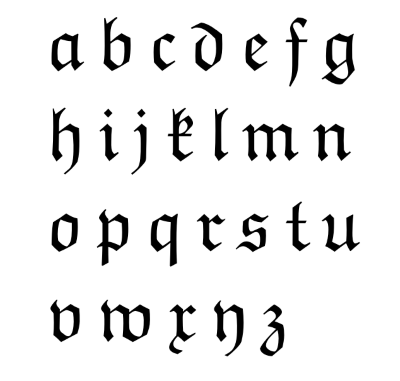When mathematicians run out of symbols, they turn to other alphabets. Most math symbols are Latin or Greek letters, but occasionally you’ll run into Russian or Hebrew letters.
Sometimes math uses a new font rather than a new alphabet, such as Fraktur. This is common in Lie groups when you want to associate related symbols to a Lie group and its Lie algebra. By convention a Lie group is denoted by an ordinary Latin letter and its associated Lie algebra is denoted by the same letter in Fraktur font.

LaTeX
To produce Fraktur letters in LaTeX, load the amssymb package and use the command \mathfrak{}.
Symbols such as \mathfrak{A} are math symbols and can only be used in math mode. They are not intended to be a substitute for setting text in Fraktur font. This is consistent with the semantic distinction in Unicode described below.
Unicode
The Unicode standard tries to distinguish the appearance of a symbol from its semantics, though there are compromises. For example, the Greek letter Ω has Unicode code point U+03A9 but the symbol Ω for electrical resistance in Ohms is U+2621 even though they are rendered the same [1].
The letters a through z, rendered in Fraktur font and used as mathematical symbols, have Unicode values U+1D51E through U+1D537. These values are in the “Supplementary Multilingual Plane” and do not commonly have font support [2].
The corresponding letters A through Z are encoded as U+1D504 through U+1D51C, though interestingly a few letters are missing. The code point U+1D506, which you’d expect to be Fraktur C, is reserved. The spots corresponding to H, I, and R are also reserved. Presumably these are reserved because they are not commonly used as mathematical symbols. However, the corresponding bold versions U+1D56C through U+ID585 have no such gaps [3].
Footnotes
[1] At least they usually are. A font designer could choose provide different glyphs for the two symbols. I used the same character for both because some I thought some readers might not see the Ohm symbol properly rendered.
[2] If you have the necessary fonts installed you should see the alphabet in Fraktur below:
𝔞 𝔟 𝔠 𝔡 𝔢 𝔣 𝔤 𝔥 𝔦 𝔧 𝔨 𝔩 𝔪 𝔫 𝔬 𝔭 𝔮 𝔯 𝔰 𝔱 𝔲 𝔳 𝔴 𝔵 𝔶 𝔷
I can see these symbols from my desktop and from my iPhone, but not from my Android tablet. Same with the symbols below.
[3] Here are the bold upper case and lower case Fraktur letters in Unicode:
𝕬 𝕭 𝕮 𝕯 𝕰 𝕱 𝕲 𝕳 𝕴 𝕵 𝕶 𝕷 𝕸 𝕹 𝕺 𝕻 𝕼 𝕽 𝕾 𝕿 𝖀 𝖁 𝖂 𝖃 𝖄 𝖅
𝖆 𝖇 𝖈 𝖉 𝖊 𝖋 𝖌 𝖍 𝖎 𝖏 𝖐 𝖑 𝖒 𝖓 𝖔 𝖕 𝖖 𝖗 𝖘 𝖙 𝖚 𝖛 𝖜 𝖝 𝖞 𝖟

The problem I have with Fraktur is how to write them with pencil and paper. While working through Stillwell’s Naive Lie Theory I came up with the solution of writing Lie Algebras as lower-case cursive letters. I felt that since Fraktur is the written script that was used in Germany in the 19th century and earlier, cursive script would be the equivalent usage in English.
When I studied physics, starting in 2006 some of the older textbooks still used a convention to denote vectors by fraktur, or by current, the version of fraktur used for handwriting by my great grandmother, instead of drawing an arrow above them. That seemed to have been widerspread in the 20th century, when Germans still learned both alphabets in school
.
The Fraktur letters show up fine on my Pixel (Android 8.1)
Lucas, Fraktur was always a family if print fonts. (But if your convention works for you, that’s great.)
can we just all agree that _that_ is not a *proper* “k”.
sorry.
The article states that “presumably [fraktur C, H, I, R and Z] are reserved because they are not commonly used as mathematical symbols” but the opposite is true; they have been excluded from the Unicode block because they have already existed in Unicode for 10 years longer, in the Letterlike Symbols block to be exact (which contains various symbols that appear as letters). These symbols were chosen early on because they are some of the *more* common fraktur symbols, with ℜ and ℑ for example being one possible notation for the real and imaginary parts of a complex number.